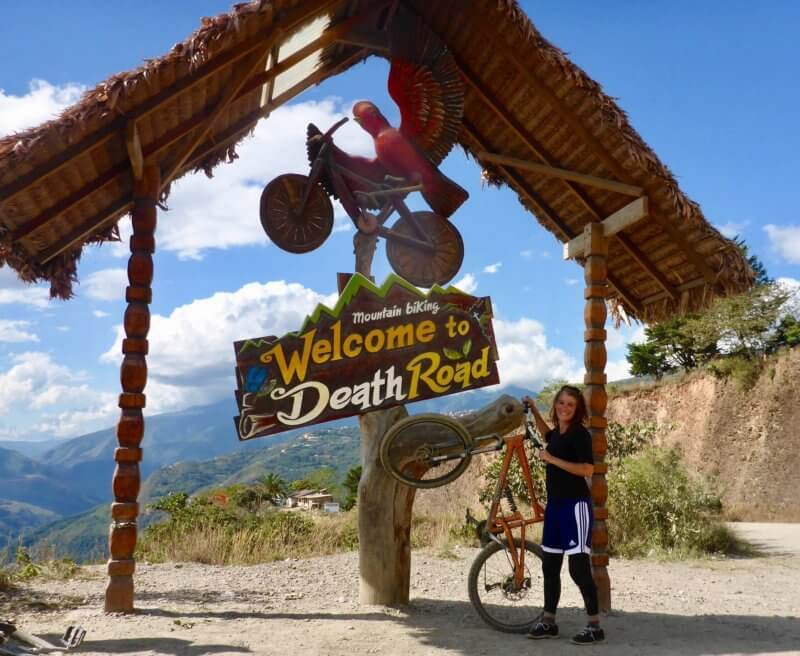Most people want to avoid going over the cliff on Death Road. I, however, really enjoyed the experience.

Everyone wants to ride a bike down the road that earned the title “World’s Most Dangerous Road,” right? Before I signed up for this madness, I had bicycled only sporadically over the past few years. “It’s like riding a bike” must mean something and I felt sure my former biking skills would resurface. (I sure hoped so because what I’d read about biking on Death Road scared the bejeezus out of me).

How “Death Road” Earned Its Title
Death Road earned the title “World’s Most Dangerous Road” back in the 1990s. Its real name is Yungas Road and it leads from La Paz to Coroico. The particularly notorious section famed for extreme bicycle excursions is a dirt/rock road that hugs the mountain on one side and sports jaw-dropping 900 meter cliffs on the other.
If you are planning a trip to Bolivia, get a taste of the culture from these novels and memoirs set in Bolivia.
Carved into the mountain in the 1930s, Yungus Road was the only road into and out of the Yungas region and regularly used by large passenger buses, crowded minivans and trucks. Death Road is only 3 meters wide and there are no guard rails. When two trucks or buses (or cyclists) come upon each other around a hairpin turn, a deadly game of chicken ensues. An estimated 200 to 300 people were killed yearly and up until 1994 an average of one vehicle plummeted over the edge every two weeks.

In 1995, the Inter-American Development Bank named Yungus, “The World’s Most Dangerous Road.” Eventually an alternate road replaced the most dangerous stretch and the majority of traffic was diverted to safer passage. However, the original Death Road is still open to vehicles and is considered a tourist attraction for cyclists. Unfortunately, Yungus continues to show no mercy and it is believed that more than 22 cyclists have lost their lives on Bolivia’s Death Road since 1998. An unsettling number of memorials line the perimeter marking the spots where lives were lost. The peril seems to be part of the allure.

Biking Death Road – Picking a Tour Company
After a day or two of acclimating upon arrival in La Paz, my friend Del and I found our way to one of the many bike tour companies in town. (FYI, they all seem to be within a few blocks of the witch’s market). I’d done a lot, I mean A LOT, of research because, well, DEATH Road! I had chosen Vertigo Biking to hold my life in its hands. Like just about any tour experience, you get what you pay for and prices will vary. There were some cheaper than Vertigo Biking and a few more expensive, but I’d read many reviews about the quality of their bikes and the staff so I felt comfortable going with a tour company with pricing on the high end of middle range.
When we arrived at the shop, Del and I filled out all the it’s-not-your-fault-if-we-die paperwork, paid the tour fee, sized our helmets and bikes and then headed back to the hotel to sleep. Yes, it was only 8:30 p.m., but we are old ladies! High altitude and a high number of years under your belt don’t add up to high action night lives. Sigh…. Anyway, at the crack of dawn the next morning we were back at Vertigo Biking ready to go and so were they.

We were still acclimating to the altitude and Del was looking increasingly less enthusiastic about this adventure. She admitted that she hadn’t been on a bike more than a handful of times in the past 40 years. I was instantly very worried. Here’s the thing. I didn’t know Del at all. We’d only met 48 hours earlier at the airport. She and I had both signed up for a Rotary Club service project helping United for Change with their project to improve literacy rates among the indigenous women in the mining communities. After exchanging only one or two emails we both decided to fly to La Paz a few days before the project started in order to explore. I had sent Del my list of things I wanted to see and do, but she was content to go along with whatever and hadn’t really read it. So, when the reality hit that she was about to embark on an extreme biking experience on Death Road in the middle of the mountains in Bolivia, she got a little nervous about whether her 67-year old arms and legs were up to the challenge. I shouldn’t have been worried – she turned out to be Daredevil Del! And besides, see that title up there? I was the one that went over the cliff, not Del.
The Adventure Begins…
After all the thrill seekers were on board we drove about an hour to La Cumbre Pass. Our descent began here in the Altiplano terrain at about 4,400 meters where the air is thin and cold. We’d been warned to layer up and were grateful for the advice.

After a safety briefing including the recommendation that we do not bring our phones (in 2011 a tourist (not with Vertigo!) fell off the cliff and died while iphone filming a friend) we spent a few minutes getting used to the bikes. Then, we gathered together to pass the bottle for a quick shot. Yep, you heard me. A shot. We were heading down Death Road and the guide was insisting we each tip a nip of 95% alcohol. Seriously? But, it was for good reason. We paid our respects to Pachamama (Mother Earth) by taking a small sip and then asking her for safe passage while splashing the alcohol on our bike and the ground. Hey, we are heading down the World’s Most Dangerous Road; I’m quite happy to pay respects to whomever necessary to make sure I reach the bottom alive. I just wish I’d thought to take my helmet off, first. That chin section is tricky to maneuver around. Ha ha ha!
Death Road – The Paved Part
The first section of the tour was actually really enjoyable! The road was wide and paved with two gigantic lanes and not much traffic. Don’t get me wrong, the cliff and its inherent dangers were ever present; but, it was a nice way to get used to the bikes. It was fun going fast around wide S-curves with wind whistling in my ears while taking in the amazing scenery. I was free to enjoy the view because the Vertigo Biking guides had their camera handy and took so many great pics of us all. Along the way we stopped several times to take photos and learn some interesting facts about Death Road. We also came to a tunnel that was off limits to bikes because there was no interior lighting. After we detoured around and picked up the paved road again, we biked for another 20 or so minutes to a section with a few roadside stands and a bathroom. (Don’t forget to bring some small change because the bathrooms cost 1 to 3 Bolivianos).

At the bathroom stop the guides loaded the bikes back onto the van and drove us about a half of an hour to the beginning of the terrifying section of Death Road. There is one family that still lives there (most had moved on) and they provide a nice covered picnic area for bikers to rest before the challenge. We enjoyed tasty lunch sandwiches, bananas and juices provided by Vertigo Biking and then we were ready to go.
Well, kind of. I think I still needed some time to get over my fear. Yikes!
Dodging Death on Death Road
The guide went over some safety rules again and then told me something that nearly made me change my mind about continuing. Looking down on the route, I had decided that biking Death Road would not be that bad if I just hugged the right side and stayed far, far away from the cliff. But, noooooo, on this stretch of the road Bolivians drive like the British. Downward traffic drives on the left side – the CLIFF side!!! That meant bikers had to stay on the left, too. Let’s just say I immediately decided I wasn’t going to go very far left of center. Frankly, I would rather get run over by a truck than go over a cliff. Or so I thought.

I had come this far so I gamely climbed onto my bike and began the descent down the rocky, pot-hole filled Death Road. It only took one jiggly wheel on the gravel size rocks to immediately transport me back to 1970-something. I was 11 years old and eagerly awaiting 7:00 pm when The Bad News Bears was to play on T.V. Maybe it was Bears II, I don’t recall. What I do recall is that I couldn’t wait to watch it and was killing time outside riding my bike up and down my quiet, suburban, well-paved, meticulous street.
My boredom and impatience for the movie led me to goof off and I was riding no-handed and leaning side to side to make the bike swerve back and forth. The next thing I know, I found myself face-planted on the macadam with serious road rash up and down both arms, my cheeks, my ears, both knees and half my lip. I’d hit a patch of 4 or 5 teeny pieces of gravel and the bike simply slid out from under me. This could easily happen, and has, on Death Road.
Avoiding Bad News on Death Road
This flashback generated sheer terror in me. Dear god, there’s gravel and rocks everywhere here on Death Road. The whole freaking road is a gravel-sprinkled-ambush-rock-covered-death-trap with a 3,000 foot cliff on its side! I gripped the handlebars, clenched my teeth and prayed I wouldn’t reenact a Bad News Bears pre-show moment. For the next three hours I suffered rolling over rocks upon rocks upon rocks feeling vibrations all the way to my teeth, numbing my arms and making my butt very, very unhappy (trust me, it wasn’t the bike. There’s just no amount of shock absorption that can handle Death Road.). I alternated between cursing myself for signing up for this stupid tour and feeling totally bad-ass for conquering it.

But, hey, let’s move on. Remember Del? Well, she went from apprehensive to madcap adventurer! At one point I was puttering along eying all stones and holes with suspicion and yet trying to maintain some dignity and not bring up the tail end. “At least Del is back there,” I thought. “I won’t be the last to arrive.” Then suddenly, a voice calls out, “Passing on your left!” and the next thing I know Del comes careening around the corner, shoots past me and barrels down the straight stretch! Go Daredevil, go!

Going Over the Edge
All right, I confess. I voluntarily went over the edge. Somewhere approximately three-quarters of the way down Death Road our guides had us stop for a break at a spot where we could zip-line over the canyon. It was an incredible experience. Although terrified of going over the edge while biking, I felt completely safe flying off the cliff while attached to a cable.

I had ridden zip-lines in many places, but this was the first time that I rode one in the flying position. I loved it so much more than sitting. The crazy thing is that while I was waiting my turn I saw one or two bike tour companies pass right by. I asked our guide, “why,” and he said that most tours do not stop because it adds more time to the day. What!? I imagine most people only ride Bolivia’s Death Road once in a lifetime. I would have been so disappointed to miss the added fun of riding the zip-line between the span of an s curve.

After the zip-line we climbed back onto our bikes and finished that last 20 minutes or so of Death Road. The guides loaded all the bikes and then drove us to a local home to rest and drink a few cervezas while they hosed down the bikes. After that short break, we stopped off at a hotel to swim, eat the included buffet dinner and generally relax a bit before heading the 3+ plus hours back to La Paz.
It was a great day. Sore butt and all.
Tips for Death Road
- You will want to book in advance during Bolivia’s summer season, especially if your time in La Paz is limited.
- In addition to the double suspension bikes, Vertigo Biking also provided us with a helmet, protective clothing and gloves. Make sure you ask your tour company what they provide.
- You would be smart to bring along a thin scarf and sunglasses and stuff a pair of shorts in your bag for when you enter the lower elevation jungle. I actually wore hiking pants with zip off legs that worked out perfectly.
- Ask your tour company if they take pictures. You will want them.
- Definitely ask if the tour you are considering will include the zip-line. (Ask if the fee is included or if it is an extra fee for those who chose to do it). It was incredible!
- Buy travel insurance. The extra insurance is really inexpensive and without it accessing medical care (especially if you go flying over the cliff less-voluntarily than I did) is incredibly expensive. Also, the reputable bike tours will likely require proof that you have it. I used World Nomads. Make sure you elect coverage for extreme sports.
On the Bookshelf
Adventure seekers will love biking Death Road. Calmer bikers will enjoy it, too. If you have any sense of adventure, put this daredevil excursion in Bolivia on your bucket list. In the meantime, whether you are planning your next vacation or content to experience Bolivia from your armchair, you’ll want to check out these books set in Bolivia.
Pssst…If you love to read and also want to live a more active, engaged life, visit The Novel Tourist Facebook page. You’ll get great suggestions for novels that will inspire you to get out and explore, even in your hometown!




Leave a Reply